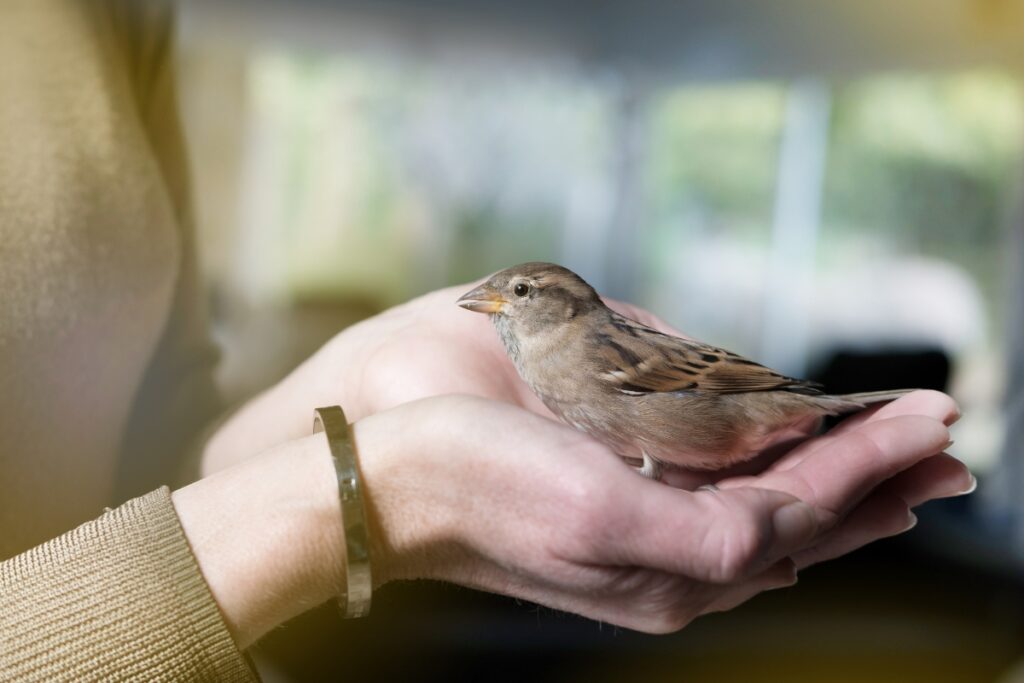As an Amazon Associate, we earn from qualifying purchases with no additional costs for you.
Some bird watchers enjoy watching birds because of an interest in how these animals behave towards each other. You may be wondering if birds would help another bird that is injured.
Birds may sometimes help an injured bird if it is its mate; this is sometimes seen in geese, which mate for life. Not all injured birds receive assistance and may be rejected. Parent birds will likely reject injured nestlings and focus their attention more on healthy and strong chicks.
Many bird species exhibit altruistic behavior, showcasing a remarkable capacity for cooperation and care within their communities. Read on to learn how birds may help each other in different situations.
TIP: If you want to check out the best pair of binoculars for bird watching, we recommend a pair of waterproof and fog-proof 8 x 42 binoculars like the Celestron – Outland X 8×42 Binoculars (Amazon link).
Do Birds Help Each Other When Injured?
There is no specific evidence indicating that birds help each other when injured. In fact, the opposite occurs in the nest. A chick that is weaker or injured in some way is most likely to be kicked out of the nest by the parent.
There is anecdotal evidence of birds showing concern or waiting for an injured mate. For instance, a swan whose mate was taken for treatment remained in the same spot where the mate was collected from. It seems the remaining swan was awaiting his mate’s return.
The below video tells the story of a Canada Goose who waited for her mate outside of a rehab center. The bird showed concern and a strong attachment to her mate.
Would Parent Birds Help Injured Or Ill Chicks?
The parents of an injured chick are more likely to reject and expel the baby from the nest. If there is more than one chick, the stronger babies would also outcompete a weaker or injured baby.
Although this seems cruel, selection works to make sure the fittest genes are passed on to the next generation. It is, therefore, more important for the population of the species as a whole to have strong and healthy birds.
Some baby birds kill their nest mates. Cuckoos are brood parasites that lay their eggs in other birds’ nests. The cuckoo chick then pushes out the eggs and chicks of the host bird to get all the food from the parent.
There is a coevolutionary arms race between cuckoos and their host species. Sometimes, the host bird recognizes and expels cuckoo eggs before they hatch.
Bird Helpers During Breeding
It is not very common, but some species of birds have cooperative breeding habits. There is some diversity in how cooperative breeding occurs. In some cases, like the Western Bluebird, the male offspring of a pair may remain to help rear the next clutch of the parents.
This is a system similar to the Florida Scrub-Jay, where offspring will remain with the parents and assist in raising subsequent offspring of the parent birds.
Other species that have cooperative breeding include the Superb Starling and Groove-billed Ani. Acorn Woodpeckers also have helpers when breeding, but they have quite a unique breeding system.
These woodpeckers are polygynandrous, meaning there are many male and female pairings. These individuals then all make one communal nest. They all care for the eggs and then chicks that hatch later.
Watch the below video on the cooperative breeding of the Superb Starling.
Colonial Nesters
Bird species either nest on their own or in colonies. Colonial species include most seabirds. Birds like the Common Murre may nest in colonies containing thousands of individuals.
Seabird colonies can be found on islands and headlands. Herons and egrets also nest in colonies. Living in colonies does appear to have a survival benefit, with many adults showing higher survival rates.
Land birds that nest in colonies include certain weaver species like the Village Weaver, Eastern Golden Weaver, and Sociable Weaver.
TIP: Are you looking for high-quality food for wild birds on your backyard? I recommend using Wagner’s products with the highest quality grains used in blending and made in the USA (Amazon links):
– Deluxe Treat Blend Wild Bird Food
– Eastern Regional Wild Bird Food
– Western Regional Wild Bird Food
– Midwest Regional Wild Bird Food
– Southern Regional Wild Bird Food
This video showcases the habits of the Village Weaver during the breeding season.
Cooperation For Predator Avoidance
Another situation where birds may cooperate is when a predator is detected. It is common to see a mixed-species flock of birds all gather in a tree to call and sometimes mob an intruder.
Usually, the first species to spot a snake will sound the alarm and give off a call that is instantly recognized by all birds in the area as indicating the presence of a dangerous intruder.
This is often seen when a snake is spotted. Soon, several birds of different species will move to the area and also start giving alarm calls. If a snake is near a nest, the birds may even physically try to peck the snake to get it to move along and away from the nest and its eggs or chicks.
TIP: Bird feeders and baths are great for attracting birds to your backyard. But what about bird houses? They will help you not only track but also keep them in your yard! Check out my picks on different bird houses below (Amazon links):
– Cedar Viewing House
– Wood Bird House with Pole
– Hanging Bird House
Flocks To Reduce Predation
Another way that birds can reduce predation is to fly in flocks and eat in flocks. Large flocks of starlings, called murmurations, can be seen in the skies of Europe. The starlings in these flocks number in the thousands, making it very difficult for a predator to swoop in and catch a single individual.
Many small birds will fly together in flocks for the same reason. It is also easier to spot a predator with many eyes looking out for danger.
The odds of being taken by a bird predator, like a falcon, are much lower if an individual bird is found in a large flock that can distract and confuse the bird predator. Tiny birds like waxbills and mannikins can often be found flying and even feeding in flocks.
TOP TIP: Have you ever wondered how many birds there are in the world? This article offers insight into the different bird species. If you rescue a baby bird, would you know what to feed it? Find out here!
Humans Helping Birds
Sometimes, a person finds an injured or orphaned bird. The best thing to do is to find a qualified wildlife rehabilitation center because treating birds takes skill, and rearing a baby bird is difficult. Baby birds also imprint easily on humans, making them unable to survive in the wild on their own. It, thus, takes special knowledge and facilities to rear a wild bird that can be successfully released.
There are a few rules or guidelines you should abide by as an ethical birder. These are listed below.
- Do not enter private lands without prior permission from landowners.
- Follow all the rules in refuges and reserves, including cleaning up any garbage from your campsite.
- Do not disturb birds on nests.
- Do not use apps and play songs to call up birds when they are hungry, tired, and breeding during spring and summer.
Conclusion
Birds are unlikely to help another injured bird. The only time this may happen is if a bird has a mate that is injured. A bird is likely to reject and expel an injured chick from the nest.
There are cases where birds cooperate. For instance, some species breed in colonies or have helpers at the nest. Birds may also cooperate by flying together in flocks, which helps reduce predation.



